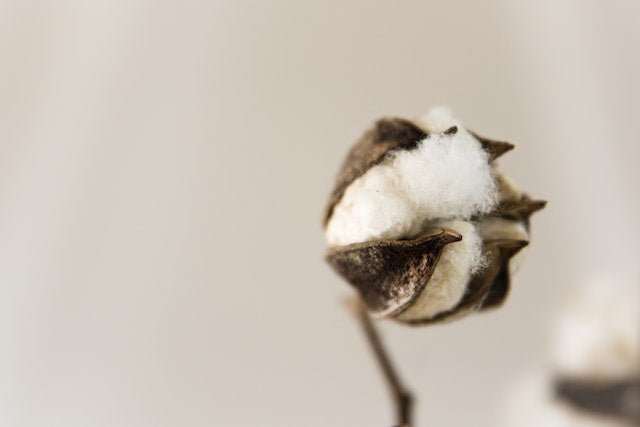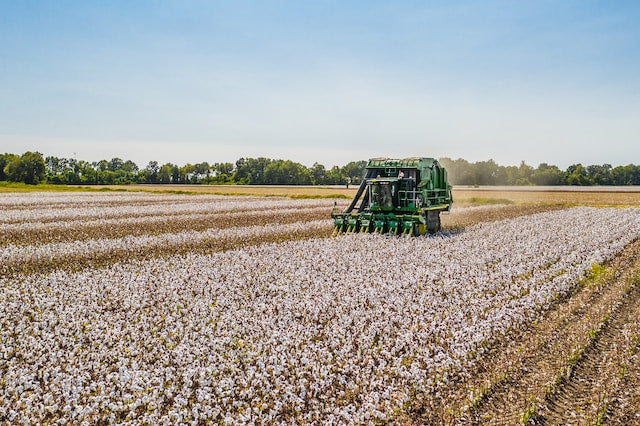Making use of lower-impact materials is one of the ways we’re improving our eco side and ensuring we make better choices for the planet.
Organic cotton is one such material we’ve been integrating throughout our current and future collections. Right now, GOTS-certified organic cotton is the primary material used across our Venture Collection.
Our Venture Tees are made from 100% organic cotton and our Venture Crews and Hoods are made up of a blend of organic cotton and recycled polyester. Our Crew Socks are also made from 80% organic cotton with 15% polyester and 5% elastane.
But what are the advantages (and disadvantages) of using organic cotton? And what makes it a better alternative to standard cotton?
How is organic cotton clothing made?

There are several stages in the process of making organic cotton clothing, from planting cotton seeds to the final garment manufacture. The process begins with the selection of non-genetically modified (non-GMO) cotton seeds.
Farmers grow the cotton without the use of synthetic pesticides and fertilizers. Instead, natural methods including crop rotation, a process whereby the types of crops grown in a field are changed across different growing seasons, intercropping, where two or more different crops are grown in the same field, and the use of natural predators such as insects to control pests and diseases, are used throughout the growth cycle.
Once the cotton plants mature, farmers handpick or machine-harvest the cotton, separating it from the seeds and other plant material using a cotton gin, a machine designed to separate cotton seeds from cotton fibre. This produces raw cotton fibres that are cleaned and prepared for further processing.
Cotton fibres are then carded, a mechanical process whereby the fibres are disentangled and intermixed before being spun into yarn using spinning machines. After this, the yarn is used to weave or knit fabric on traditional looms or knitting machines before undergoing finishing processes such as dyeing (with non-toxic dyes), softening, printing, cutting, and sewing.
The benefits of Organic Cotton

Opting for organic cotton supports ethical and lower-impact practices within the clothing manufacturing industry, promoting the well-being of both the environment and the people involved in its production.
The cultivation of organic cotton helps conserve water and promote soil health while reducing the use of synthetic chemicals. By eliminating the use of synthetic pesticides, insecticides, and fertilizers, it helps minimise soil and water pollution while protecting biodiversity.
Organic cotton farms also aim to encourage the growth of diverse crops and vegetation. Therefore, supporting natural ecosystems and providing habitats for important insects and wildlife.
Environmental factors are not the only benefits of organic cotton farming. Humanitarian benefits are also seen, as organic cotton farms often prioritise the welfare of farmers, workers, and local communities. This is ensured through the requirement for official certification that takes into account the quality of working conditions.
Strict guidelines and practices must be adhered to throughout the process of organic cotton farming, and certification from organisations such as Global Organic Textile Standard (GOTS), is required to allow for traceability and to ensure these standards are upheld.
Limitations of organic cotton…

Organic cotton is a great alternative when it comes to lower-impact materials. However, like everything, it has its limitations and challenges.
In general, organic cotton farming yields lower quantities than conventional methods. One reason for this is the absence of synthetic fertilizers and pesticides, meaning farmers must use alternative processes to take care of weeds and insects. These are often more time-consuming and labour-intensive processes. Organic cotton also requires the maintenance of healthy soil to sustain growth.
The extra time and work that goes into cultivating organic cotton subsequently drives up the price. So, organic cotton products are often more expensive than products made from non-organic cotton.
Factors such as limited availability, growing global demand, the time and expense of gaining certifications, and the need for increased education and awareness among both farmers and consumers are just a few other limitations in the production of organic cotton, which add to increased costs.
Looking to the future…
While there are currently many limitations and obstacles in the production of organic cotton, the future of this lower-impact material looks promising as demand and awareness increases globally.
As we continue to see innovations in farming practices, new advancements in technology, and greater collaboration between farmers, textile manufacturers, and brands, there is huge potential for organic cotton to become one of the main lower-impact materials used globally.
Want to know more about the materials we use? Check out our post on RPET here: Focus on Fabrics: What is RPET?





Leave a comment
This site is protected by hCaptcha and the hCaptcha Privacy Policy and Terms of Service apply.